Chapter 5 – Sensing and Responding to the Environment
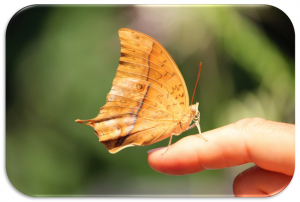
Survival. For any living organism, that is more or less job one. If you don’t survive, you won’t need to do any of the functions detailed in Chapters 2-6. As we have stated many times, humans and insects face similar challenges in the real world, but due to differences in anatomy and physiology, we handle them in different ways. The ability to survive is clearly essential to both insects and humans. And, in both cases, the capacity to procure resources (i.e. food, water, shelter, mates, etc.) and avoid hazards that might bring life to an abrupt end depend heavily on the nervous system. In this chapter we will focus on the structure and function of the insect and human nervous systems. We will also consider the similarities and differences between how insects and humans acquire and process sensory information.
Overview of the Nervous System
Functions of the Nervous System
The nervous system has two general functions. First, the nervous system allows animals to obtain information from the external environment, process it internally, and respond appropriately. For example, if an insect needs food, it will search the environment for the presence of its preferred food. This process will be mediated through a variety of senses, such as vision, olfaction (smelling), and perhaps, hearing, taste, and touch as well. Yes, insects operate with competence in all five senses just as humans do! If an appropriate food source is located, the insect will take actions to secure that food, which will likely include telling its muscles to move towards the food source, extend the feeding apparatus, and ingest the food. Thereafter, internal processes, also mediated by the nervous system, will take over.
As all of this is playing out, the insect in search of food must monitor the environment for signs of danger. Are predators lurking? Are environmental conditions acceptable for being out and about? Is the potential food source laced with poisons put there by humans who are trying to prevent insects from eating it? If an insect detects any of these hazards, it may decide to look for another food source instead. Clearly, we humans also have nervous systems that can do everything the insect can do, and considerably more! The important point is that both insects and humans are bombarded with a continuous stream of information coming in from the environment. It is the job of the nervous system to filter out the important information from the background signals and respond appropriately. Clearly it is a job that will not afford a lot of time off without jeopardizing survival.
The second major function of the nervous system in both humans and insects is to monitor the environment inside the body. Indeed, the nervous system, often in conjunction with the endocrine system, does extensive work in maintaining the numerous homeostatic functions we have discussed in previous chapters, such as regulating respiratory rates, circulation, digestion, excretion/water balance, growth, and development, as well as reproduction (to be discussed in Chapter 6). The nervous system monitors the internal environment, or the milieu interior as Bernard deemed it, and determines whether actions should be taken to change internal processes to more acceptable levels. If changes are needed, hormones and/or enzymes might be released, or internal processes might be kicked up a notch or lowered in order to maintain homeostasis. Adjustments could also involve having the brain tell the muscles to take some action. Good health and, ultimately, survival depend on the ability of the nervous system to carry out these important functions.
Basic Structure of the Nervous System: Neurons
All organisms with a nervous system operate using a specialized cell called a neuron (Figure 5.1). Structurally, neurons are all basically the same, regardless of the organism in which they are found. There is, of course, the cell body that contains all of the usual organelles found in eukaryotic cells, such as the nucleus, mitochondria, Golgi apparatus, etc. Additional structures of the basic neuron include the highly branched dendrite, which receives neurological messages from other neurons or sensory organs and passes them to the receiving neuron through its axon, a long unbranched process that conducts neurological messages to other neurons or muscles/glands. Messages are sent as electrical pulses that reverse the polarity of the nerve membrane, a phenomenon called the action potential, which is then transmitted along the length of the axon. Although the structure of the basic neuron is the same from organism to organism, there are three different functional types of neurons.
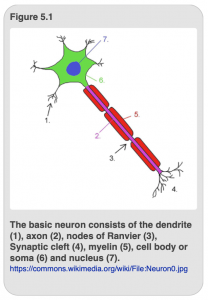
The first type are sensory neurons (also known as afferent neurons), which carry information from the sense organs (eyes, ears, mouth, nose, etc. in humans; eyes/ ocelli, tympanum, mouth, antennae, etc. in insects) to the spinal cord and brain (or insect equivalent). This is how organisms perceive what is going on in the environment around them. The brain processes and evaluates signals and/or threats posed to the organism, should they exist, and enables the organism to take appropriate action if some such stimulus is perceived. Second, motor neurons (also known as efferent neurons) carry messages from the brain and spinal cord to muscles and glands around the body. This is one pathway by which an organism will respond to information the brain has processed from external stimuli. One major possible action is to tell the glands to release hormones that induce the organism to flee. Additional signals will then be sent to the muscles to carry out that action. Finally, interneurons receive messages from sensory neurons or other interneurons and transmit messages to other interneurons and/or motor neurons, completing the circuit and allowing the seamless processing of messages and responses.
We know that neurons are relatively standard from animal to animal, without much variance in the way they look or how they perform. However, there are huge variations among organisms in terms of the number of neurons they possess. Relatively simple organisms, such as insects, have a relatively small number of neurons. Complicated organisms like parakeets, pandas, or people, however, have billions of neurons. Thus, as the number of neurons increases, the number of responses available to that organism in any given situation also increases. For instance, if an insect perceives that it is about to get eaten, its main defense may be to escape from the predator by fleeing. To be fair, insects are also capable of standing their ground and assaulting the potential predator with a variety of toxic sprays, bites, stings, froths, foams, and even toxic vomit! Insects are nothing, if not creative. In contrast, if a human perceives a similarly mortal threat, the human will have many more potential remedies, beginning with prevention. A human might simply avoid areas where he or she is likely to face danger, or he or she could make a preemptive plan to help mitigate the threat should it arise. If all else fails, the human might try to run away, like the insect, or turn and face the threat directly.
Given this information, it is not difficult to understand that the part of evolutionary history of living organisms, particularly animals, has been to increase the number of neurons, thus affording greater complexity of capabilities as the number of neurons increased. As an evolutionary process, our understanding of this phenomenon is that individuals endowed with more neurons had a greater prospect for survival and hence would produce more offspring. Over time, and through continuous selection, the proportion of individuals having more neurons increased. Similarly, as the number of neurons increased, so did the complexity of the nervous system and its structure. Indeed, in humans, there are so many neurons that they become clustered into units to permit advanced, efficient information processing. Furthermore, the number of connections between neurons and other structures increases in complex nervous systems to allow efficiently distributed processing, multilayered perceptions, and an increased ability for response. Finally, as the number of neurons increases, experiences themselves can be stored as memories, recalled when needed, and used to make future decisions.
Humans, therefore, are the pinnacles of neuronal processing—as far as we know. Our large brain helps us execute basic survival functions, but that is just the beginning. We can do amazing things, like anticipate a desirable future outcome and then undertake actions to secure that outcome, and/or avoid a negative one. We might share our goals with others in advance of achieving them and get input from those who have more experience or resources. When we’ve accomplished something meaningful, we might reflect on its utility or beauty. We might choose to share our accomplishment with others and allow them to use the resources we’ve just acquired because it is the right and moral thing to do. Then, in our free time, we might compose a piece of music to commemorate our success and encourage others to do the same. We all have an inner Einstein and/or Mozart; it is just a matter of finding the time and giving the requisite effort to create great things. It’s also a matter of how many neurons we have.
Similarities and Differences between the Nervous System in Insects and Humans
The Human Nervous System
You are all (hopefully) somewhat familiar with our own nervous system and realize that the bulk of our information processing occurs in our brain and spinal cord, which together comprise our central nervous system (CNS; Figure 5.2). Our central nervous system integrates information from multiple sources and coordinates sophisticated responses. It does this through connections with our peripheral nervous system (PNS), which consists of nerve fibers that extend throughout the body. In addition to coordinating somatic (voluntary) responses, our peripheral nervous system also manages involuntary processes like releasing energy stores when we are in stressful situations (courtesy of the sympathetic nervous system) and helping us to relax after stressful situations have subsided (mediated by the parasympathetic nervous system). Additionally, digestive processes are controlled by the enteric nervous system (ENS), now considered to be a “second brain” since it can operate independently of the CNS and PNS. The ENS is composed of millions of sensory, motor, and interneruons, and synthesizes over 30 neurotransmitters to use in conveying neuronal messages, many of which are identical to those found in the brain. Yet in spite of these additional and essential nervous systems, humans are undoubtedly highly cephalized, meaning that most of our neural activity is concentrated in our brains such that we cannot survive without them. As we will see in the next section, the same is not true for insects.
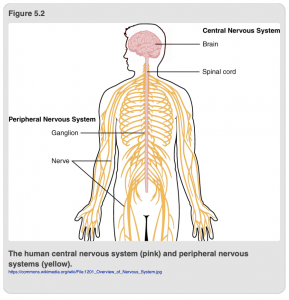
The Insect Nervous System
This brings us to the matter of organizing the nervous system. Even relatively simple nervous systems such as those found in insects are complicated enough to require the partitioning of functions into sub-units (Figure 5.3).
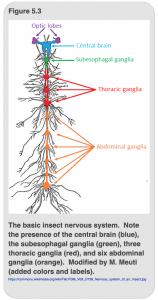
Although it may surprise you to learn this, insects do actually have brains, and they are even located in their heads! The brain is connected to a ventral nerve cord that is punctuated by the presence of ganglia throughout the thoracic and abdominal segments. The ganglia are collected bundles of neurons that serve, in essence, as helper brains. Interestingly, experiments have shown that an insect deprived of its head will not only not die immediately, but can actually avoid painful stimuli even in its headless condition thanks to the ganglia’s ability to coordinate limited movements. Some of the functions of the brain and other components of the insect nervous system are to coordinate muscle movements and behaviors (walking, molting, flight, mating, defense, etc.), perceive sensory information (i.e. visual, chemical, auditory, and pressure signals), and coordinate appropriate responses, release hormones and enable learning. And this is just an abbreviated list!
Despite its relatively simple structure, the insect nervous system is nonetheless capable of some pretty remarkable things. In addition to allowing insects to locate the resources they need and avoid threats in order to survive and reproduce, insects can learn. Some social insects have a type of language they use to communicate with other members of their own colony. Honey bees, for instance, can go out into the world, locate flowers that have nectar, return to the hive and, using a highly specialized dance, communicate the location of the food resource to the rest of their nestmates. Some insects have highly structured social castes with specific functions allocated to each caste, and this not only requires sophisticated communication but also cooperation.
Sensory Perception
Just like humans, insects have the organs necessary to support all five senses that (most) humans use to navigate through the world: vision, touch, taste, hearing, and smell. But the structures and the locations of these structures that insects use to receive sensory information are somewhat different than those used by humans.
On a somewhat more technical note, although we commonly recognize five distinct senses in our own bodies (sight, smell, taste, touch, and hearing), really these only represent the reception of three different types of signals: light, chemicals, and physical disturbances. Therefore, sensory receptors in both insects and humans are named for the type of signal they transduce in insects. For example, photoreceptors receive and respond to light (photons) as the name suggests, and hence are present in both human and insect eyes. Mechanoreceptors respond to changes in air pressure, orientation, or a mechanical disturbance in the environment, such as movement or vibration. Both the senses of touch and hearing are mediated through mechanoreceptors. Finally, chemoreception involves detecting specific chemicals in the environment, generally by binding to specific to chemoreceptors having the appropriate shape. In insects and humans, both the sense of smell (chemicals found in air) and taste (chemicals dissolved in liquids) are types of chemoreception. Interestingly, the receptors for taste and smell can be found virtually anywhere on the insect including their feet. We think you will agree that it takes real talent to taste with your feet!
The basic mechanism underlying the ability of insects and humans to sense a relevant environmental cue (a photon, mechanical disturbance, or chemical) is the same. First, the stimulus must activate the appropriate receptor by stimulating a neuron found in the receptor. This creates a neurological message that can then be sent either to the brain or ganglia for further processing and production of the appropriate response. Let’s now look at some specific examples of the environmental cues and compare and contrast receptors that produce responses in both insects and humans. We will begin with photoreception, the sense of vision.
Photoreception
Like humans, insects do have eyes, but the structure is quite different in the two organisms, and these structural modifications lead to some fairly major differences between human and insect vision. In humans, light enters the eye through the cornea and then through the pupil and onto the lens (Figure 5.4). The lens focuses the image onto the back of our retina where we have specialized cells for reception. Neuronal messages are sent along the optic nerve to the brain to make sense of the image detected by the eye. Further, the human eye is located on the front of the head and projects forward.
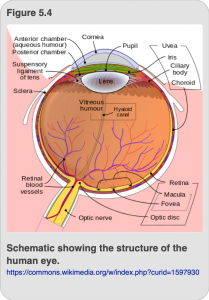
Because of our ability to change the focal length of the lens through muscular contractions, our eyes are great at discerning detailed images and perceiving the depth or distance between objects. However, our eyes do not function well in low-light environments, are responsive to a relatively narrow band of light wavelengths, and do not allow us to detect predators or other dangers that are approaching us from behind. But of course, we have other senses to assist there.
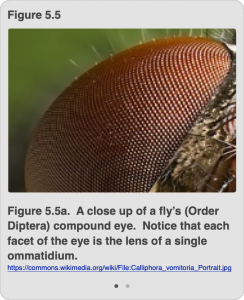
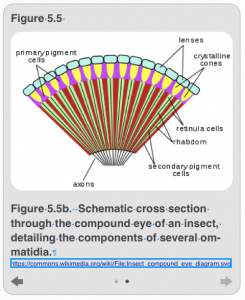
In contrast, the insect eye is composed of up to 3,000 subunits called ommatidia (Figure 5.5a,b), sometimes called “little eyes.” Because of its construction, most insects can see in every direction even without turning their heads. This is the main reason why you cannot swat that pesky fly; it will see your hand coming and take evasive action long before you can smash it. The number of ommatidia influences resolution—the more ommatidia an insect eye has, the greater its ability to discern the details of an image. Still, compared to humans, insect eyes are not as proficient at seeing detail, in a large part because their lenses and the crystalline cones that focus the light are composed of inflexible chitin. Therefore, insects cannot adjust the focal length of their eyes resulting in near-sighted vision, with most objects appearing blurry. Insects are better at seeing images in broad outlines and are especially good at detecting movements (Video 5.1).
A final aspect of insect vision that deserves attention is that insects can see in ultraviolet (UV) range, whereas these high energy wavelengths are too short for the human eye to see. Certain flowers have evolved patterns that are visible in the UV range to attract insect pollinators. Consequently, the flower world looks remarkably different to insects than it does to humans as Figure 5.6 illustrates. UV light is also used by the people who make bug zappers to lure insects into the contraption where they are then killed (but sadly these devices mostly kill beneficial and harmless insects and don’t put much of a dent in the mosquito population).
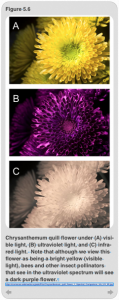
Mechanoreception
As we stated earlier, both insects and humans perceive touch using mechanoreceptors. In fact, the basic physiological principle upon which touch is based hasn’t changed appreciably in 600 million years of evolutionary time, the point at which multicellular life forms came into being. In essence, physical force is translated into a neurological message to give rise to the touch sensation. In humans, mechanoreceptors are found in the skin at varying depths, and are specialized to perceive different types of touch (e.g. a light breeze, a gentle touch or a firm squeeze; Figure 5.7). The palms and the rest of the hands in humans are responsible for perceiving 90% of the touch signals.
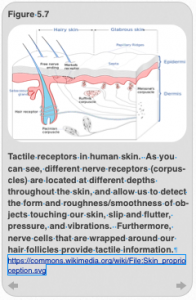
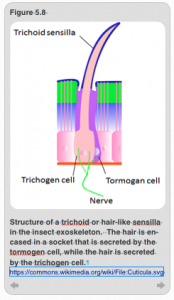
Like humans, insects have a sense of touch—a tribute to the fact that touch is among the oldest sensory modalities and is, therefore, common to all animals. In insects, the sense of touch is detected by several different types of sensory cells, or sensilla, that are distributed across the body. The most common mechanoreceptors are hair-like trichoid sensilla (Figure 5.8). When one of these hairs is bent, it causes an action potential, or neurological message, to be generated inside a neuron contained within the hair. The neurological message is then sent to the ventral nerve cord for further processing, which results in the sensation of touch for the insect.
As we mentioned previously, hearing is also a form of mechanoreception, albeit a much more fine-tuned form capable of detecting slight differences in sound waves that pass through the air. Indeed, the sense of hearing in humans requires quite a lot of sophisticated equipment. Sound waves reach the ear creating a difference in air pressure on either side of the tympanic membrane of the middle ear. The difference in air pressure stimulates the auditory nerve that sends a neurological message to the brain (Figure 5.9a). But, depending on the type of sound signal it receives, the neurological message could be sent to various different places in the human brain (e. g., the language center in the left brain, or if there is emotional content in the sound, the message might also be sent to the hippocampus in the limbic system). In this case, the frontal cortex of the brain would rapidly interpret both the literal and emotional content of the message, before activating an appropriate response to the message. Aren’t our ears and brains amazing?!?
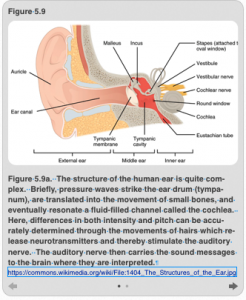
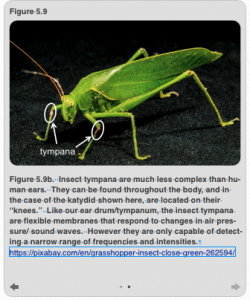
Not surprisingly, hearing in insects is quite a bit simpler but is still basically an exercise in mechanoreception, just as it is in humans. Insects do have “ears” but they can be simple one-celled organs, such as an innervated hair that responds to changes in air pressure. The sound-sensing organ can be fitted with a membrane for detecting differential air pressure and the receptor may be surrounded by various cuticular excrescences (outgrowths) that serve a protective function. An example of an insect ear called a tympanum appears in Figure 5.9b. While the ears of humans and katydids look quite different initially, please recall that they all operate on the principle of mechanoreception. Unlike humans and other mammals where the sense of hearing is located in ears that are always on the head, mechanoreceptors for the processing of sound in insects can be distributed all over the insect body. Some common places for insect sound reception are at the base of the antennae (Johnston’s organs found in mosquitoes and other flies), sides of the abdomen (grasshoppers, cicadas and some moths), or on the upper tibia/knees (katydids and crickets).
Chemoreception
As we previously mentioned, smell and taste are both forms of chemoreception, even though we might think of them as being distinct. For both humans and insects, aqueous chemicals (chemicals that are dissolved in water) are “tasted,” whereas gaseous, airborne chemicals are “smelled.” However when either insects or humans “taste” or “smell” various compounds, it is a result of chemicals binding to chemoreceptors located somewhere on the animal’s body. While we are very familiar with the location of our own chemoreceptors in our mouths and noses, insects are much more creative.
In humans, the experience of taste is largely mediated by taste buds on the tongue. There are gustatory hairs that line the pores of taste buds. When the appropriate chemical binds to the hairs, it elicits a neurological response that is sent to the brain where the sensations of sweet, sour, bitter, salty, and umami are processed (Figure 5.10).
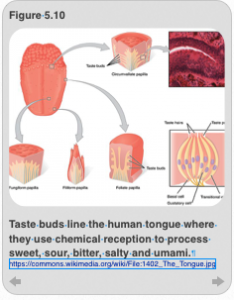
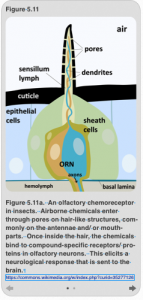
Just as in humans, both taste and smell are the province of chemoreceptors in insects (Figure 5.11a). The two processes are differentiated by how the chemicals binding to receptors get to those receptors (similar to humans). Regardless of whether the chemical was initially present in the air or dissolved in a liquid, the chemical binds its associated chemoreceptor, which induces a neurological message. This message is then sent to the insect brain or ventral nerve cord to produce a response. Typically, there will be several dendrites within a single chemoreceptor, each one of which has the capacity to respond to a range of chemical groups, e.g., sweet, salty, sour/acidic chemicals, and umami (savory/ protein-rich). A significant difference between chemoreception in humans and insects is that in humans the process is restricted the mouth and nose. In insects, chemoreceptors can be distributed all over the body, including the mouth, feet, wings and even the ovipositor (Figure 5.11b).
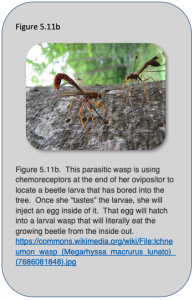
Summary
In closing, let us reiterate that insects and humans are faced with similar problems. Insects and humans all need to be able to sense changes in their internal and external environments. For example, both you and an ant might smell pizza at a picnic, although you would use your nose and she would use her antennae. Having acquired this information about a delicious and (somewhat) nutritious food source through your sensory neurons, both you and the ant would then transmit the delicious pizza smells as electrical and chemical signals to the processing centers in your nervous systems. Then, the information is integrated with other sensory information (i.e. have you eaten recently? are there any threatening people/ insects near the pizza? is there enough pizza for you and your friends?). Then, both you and the ant would evaluate the situation using your brains and peripheral nervous systems to coordinate an appropriate response using motor neurons (e.g. walking towards or away from the pizza, sending a text/pheromone message to your friends to come join you).
Isn’t it impressive that despite being so structurally different, insects and humans both have nervous systems that are designed to fulfill these important functions? Furthermore, isn’t it amazing that the basic structure of the neuron is nearly identical in insects and humans? And yet our ability to perceive and respond to external stimuli is generally so much more sophisticated and nuanced mainly because we have so many more neurons that are more organized. Although many of our sensory organs are more complex than those in insects, for example the differences between our ears and those of a katydid, the simplistic systems in insects are still highly effective: katydids can hear their lover’s songs, flies can taste pie simply by landing on it, and honey bees can see incredible patterns on flowers while flying far above them on a cloudy day. It truly is a wonder to consider that both humans and insects use the basic neuron to accomplish similar goals, while adapting to the particulars of their respective anatomical and physiological attributes and allowing us and them to thrive in our different ecological contexts.
References
Chapter 5 Cover Photo: Butterfly. CC0 Public Domain: Olivia108. Accessed via pixabay.com
Figure 5.1: The basic neuron. CC-BY-SA 3.0: NickGorton. Accessed via https://commons.wikimedia.org/wiki/File:Neuron0.jpg
Figure 5.2: The human nervous system. CC-BY 4.0: OpenStax. Accessed via https://commons.wikimedia.org/wiki/File:1201_Overview_of_Nervous_System.jpg
Figure 5.3: The basic insect nervous system. Original diagram Public Domain: author unknown. Modified by M. Meuti (added colors and labels). Accessed via https://commons.wikimedia.org/wiki/File:PSM_V09_D739_Nervous_system_of_an_insect.jpg
Figure 5.4: Human eye. Public Domain: Rhcastilhos. Accessed via https://commons.wikimedia.org/w/index.php?curid=1597930
Figure 5.5a: Fly eye. CC-BY-SA 3.0: JJ Harrison. Accessed via https://commons.wikimedia.org/wiki/File:Calliphora_vomitoria_Portrait.jpg
Figure 5.5b: Insect eye diagram. CC-BY-SA 3.0: Bugboy52.40. Accessed via https://commons.wikimedia.org/wiki/File:Insect_compound_eye_diagram.svg
Figure 5.6: Chrysanthemum quill flowers. CC-BY-SA 3.0: David Kennard at www.davidkennardphotography.com. Accessed via https://commons.wikimedia.org/wiki/File:Chrysanthemum_quill_flower_1_Spectral_Comparison_Vis_UV_IR.jpg
Figure 5.7: Tactile receptors in human skin. CC-BY-SA 3.0: Thomas.haslwanter. Accessed via https://commons.wikimedia.org/wiki/File:Skin_proprioception.svg
Figure 5.8: Insect sensilla. CC-BY-SA 3.0: Xvazquez. Accessed via https://commons.wikimedia.org/wiki/File:Cuticula.svg
Figure 5.9a: Human ear. CC-BY 4.0: OpenStax. Accessed via https://commons.wikimedia.org/wiki/File:1404_The_Structures_of_the_Ear.jpg
Figure 5.9b: Insect tympanum. Original photograph CC0 Public Domain: Josch13. Modified by W. S. Klooster (arrows and text). Accessed via https://pixabay.com/en/grasshopper-insect-close-green-262594/
Figure 5.10: Human taste buds. CC-BY 4.0: OpenStax. Accessed via https://commons.wikimedia.org/wiki/File:1402_The_Tongue.jpg
Figure 5.11a: Insect chemoreceptor. CC-BY-SA 4.0: AlphaPsi. Accessed via https://commons.wikimedia.org/w/index.php?curid=35277126
Figure 5.11b: Ovipositing Ichneumon wasp. CC-BY-SA 2.0: Seney Natural History Association. Accessed via https://commons.wikimedia.org/wiki/File:Ichneumon_wasp_(Megarhyssa_macrurus_lunato)_(7686081848).jpg
Video 5.1: Insect mosaic vision. By Larry Keeley. Available at https://www.youtube.com/watch?v=F0MqmNUz6WI
Additional Readings
Insect Vision: http://cronodon.com/BioTech/Insect_Vision.html
The Grasshopper Nervous System: https://www.st-andrews.ac.uk/~wjh/jumping/motorsys.htm
Taste maps: https://bsclarified.wordpress.com/2011/07/07/are-you-tasting-saltiness-sweetness-sourness-or-bitterness/